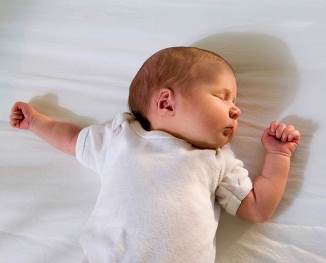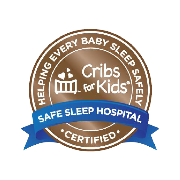Every year more infants die from preventable, sleep-related deaths than in motor vehicle crashes. The cause? Unsafe sleep environments, such as sleeping in the same bed with an adult or sibling, sleeping on couches, car seats and other surfaces for a prolonged duration, and sleeping with too many pillows, blankets and plush toys in a crib. Although the incidence of sudden infant death syndrome, or SIDS, is on the decline, mortality rates among infants from suffocation from co-sleeping are on the rise.

Rady Children’s Hospital and the Center for Healthier Communities have launched Safe Sleep San Diego to increase awareness among parents and caregivers of safe and unsafe sleep environments. As part of this effort, the Center for Healthier Communities has partnered with Community Housing Works on a community outreach program.
Rady Children’s Hospital has also established a policy on safe sleep practices based on best-practice guidelines from the National Institutes of Health, the American Academy of Pediatrics and the Consumer Product Safety Commission.
Rady Children’s has been designated a Bronze Safe Sleep Hospital by the National Safe Sleep Hospital Certification Program. Learn more.
ABCs of Safe Sleep
Parents and caregivers can help keep children safe by following the ABCs of safe safe sleep. This should be done every time a child sleeps, both at night and during nap times.

A= Alone (not with other people, pillows, blankets or stuffed animals)
B = on my Back (not on my stomach or side)
C= in my Crib (not on an adult bed, sofa, couch or other soft surface)
More ways to keep your child safe:
- Remove your child from his/her infant car seat when not traveling in a vehicle or when not being carried between locations. Infant car seats are not replacements for cribs or PackNPlays for prolonged sleeping.
- Purchase a moveable play yard, such as a PackNPlay, to take with you when you travel and to ensure a safe sleep environment every night and day of the year.
Video: Dangers of over-bundling your baby
National Safe to Sleep Campaign
The National Institutes of Health’s Safe to Sleep, a public education campaign started in 1994 to reduce the risk of sudden infant death syndrome (SIDS) and other sleep-related causes of death, has helped to reduce SIDS. SIDS is the leading cause of death in infants between 1 month and 1 year of age. Each year, nearly 3,500 cases of SIDS are reported in the United States while an additional 2,000 deaths are connected to other unsafe sleep practices. Since the start of the Safe Sleep Campaign, SIDS rates in the U.S. have decreased by almost 50 percent, both overall and within various racial/ethnic groups.
Resources
Resources are provided below to help parents create a safe sleep environment for their child whether at home or while traveling. These include information on proper bedding, proper sleep positions and, most importantly, proper sleep locations.
If you have any questions or concerns about creating a safe sleep environment, speak to your child’s pediatrician or contact the Safety Store (located in the Center for Healthier Communities) at 858-966-7573.
What Does a Safe Sleep Environment Look Like?
What Does a Safe Sleep Environment Look Like? (En Español)
Written Publications

- Safe Sleep for Your Baby (General Audience)
- Safe Sleep for Your Baby (En Español)
- Safe Sleep for Your Baby (African American Audience)
- Safe Sleep for Your Baby (American Indian/Alaska Native (AI/AN) Audience)
- Safe Sleep for Your Grandbaby (English)
- Safe Sleep for Your Grandbaby (En Español)
- Honor the Past, Learn for the Future: Reduce the Risk of SIDS & Other Sleep-Related Causes of Infant Death (American Indian/Alaska Native Outreach)
- Safe to Sleep Doorhanger (General Audience)
- Safe to Sleep Doorhanger (African American Audience)
- Safe to Sleep Doorhanger (En Español)
- Prevention of Sudden Infant Death System (Centers for Disease Control and Prevention)
- Guidelines for Infant Sleep Safety and SIDS Risk Reduction (American Academy of Pediatrics)
- Safe to Sleep – Crib Information Center (Consumer Product Safety Commission)
Video Links
- Safe Sleep Video: 1 minute (National Institutes of Health)
- Safe Sleep Video: 1 minute (National Institutes of Health) En Español
- Safe Sleep Environment for Parents and Trusted Caregivers: 2 minutes (National Institutes of Health)
- Safe Sleep Recommendations from the American Academy of Pediatrics: 2 minutes